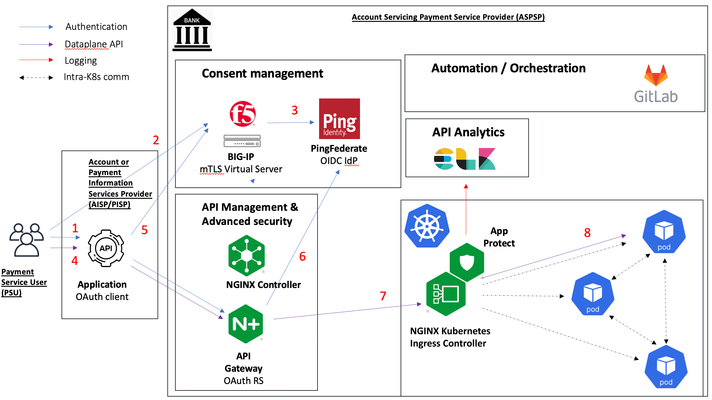PingFederate
1 TopicIntegrating NGINX Controller API Management with PingFederate to secure financial services API transactions
Introduction The previous article in the "Securing financial services APIs" series, "Using NGINX Controller API Management Module and NGINX App Protect to secure financial services API transactions", described a setup where NGINX Controller APIm, acting as an OAuth Resource Server, was using F5's APM as an OIDC IdP / OAuth Autorization Server in an OAuth/OIDC authentication flow. The current article explores the integration of NGINX Controller APIm with PingFederate, one of the market leading identity management solutions, in a similar setup. Ping Identity has partnered with OBIE (Open Banking Implementation Entity) the body responsible for UK Open Banking implementation as a response to EU's PSD2 directive and, as such, it acquired a front seat in the development of Open Banking initiative, one of the most mature examples of financial service API. Ping Identity technology is also Financial-Grade API (FAPI) compliant, supporting the features critical in ensuring higher security for financial API transactions, while maintaining seamless user experience and ease of configuration. Ping Identity's PDS2 & Open Banking technical solution guide can be found here, while this article focusses primarily on the ease of configuration of NGINX Controller APIm to interact with PingFederate solution in a basic financial services API scenario. Setup For demo purposes, as a backend banking application we used a server stub generated from UK Open Banking's OpenAPI spec deployed in a Kubernetes environment, having NGINX App Protect deployed on Kubernetes Ingress controller as an API WAF. The API Gateway and API Management function is implemented by NGINX API Gateway and NGINX Controller APIm, placed in front of the Kubernetes environment. The configuration of all the above (backend server, NAP/KIC and NGINX APIm) is managed through a CI/CD pipeline configured in Gitlab, simulating a modern application development environment. Authentication and API flow This demo is implementing the Authorization Code flow to enable a "domestic payment" transaction. Summarising the steps of the authentication and API flow (refer to the setup diagram above): 1. The user logs into the Third Party Provider application ("client") and creates a new funds transfer 2. The TPP application redirects the user to the OAuth Authorization Server / OIDC IdP - PingFederate 3. The user provides its credentials to PingFederate and gets access to the consent management screen where the required "payments" scope will be listed 4. If the user agrees to give consent to the TPP client to make payments out of his/her account, PingFederate will generate an authorization code (and an ID Token) and redirect the user to the TPP client 5. The TPP client exchanges the authorization code for an access token and attaches it as a bearer token to the /domestic-payments call sent to the API gateway 6. The API Gateway authenticates the access token by downloading the JSON Web Keys from PingFederate and grants conditional access to the backend application 7. The Kubernetes Ingress receives the API call and performs WAF security checks via NGINX App Protect 8. The API call is forwarded to the backend server pod NGINX APIm configuration In this scenario, NGINX APIm is performing the Resource Server OAuth role, where it downloads the JWKs from the OAuth Authorization Server / OIDC IdP (PingFederate) and checks the authenticity of the access token presented in the API call. Additionally, it may apply further checks to conditionally grant access to the application - in this demo it will check for the presence of the "payments" scope. The NGINX APIm configuration is straightforward and consists of two steps: 1. Configuring the IdP Go to Services => Identity Providers and click on Create identity Providers. Fill in the mandatory parameters Name, Environment and Type (JWT). Enter the JWKs URL location and the caching duration. 2. Configuring the OAuth authorization and conditional access criteria Go to Services => APIs , select an API Definition and edit the associated Published API. Navigate to Routing and edit the Component to be protected, navigating to Security/Authentication. Select the previously created Identity Provider and optionally enable conditional access. As an example, access is granted if "payments" is one of the scopes found in the access token. Conclusion NGINX APIm offers a very simple yet granular way of configuring NGINX API Gateway as an OAuth Resource Server and allows the integration with an industry-leading IAM solution, PingFederate, to protect financial services API transactions. Links UDF lab environment link.1.1KViews1like0Comments
